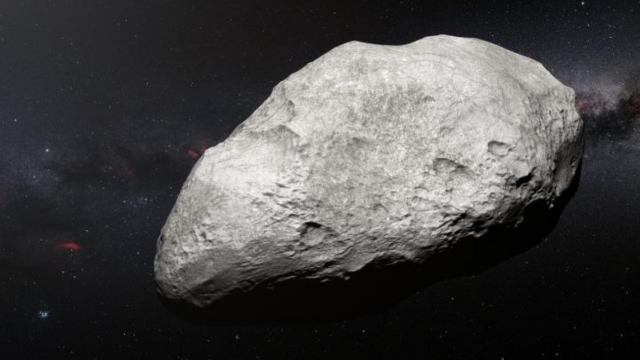A rock that formed in the asteroid belt between Mars and Jupiter seems to have somehow travelled to the orbit of Neptune, according to a new observation.
Artist impression of 2004 EW95. Illustration: ESO/M. Kornmesser
When scientists first observed the 291km-wide asteroid dubbed “2004 EW95”, they immediately knew something strange, based on the way it reflected too little ultraviolet light. When they took another look at it with the Very Large Telescope in Chile, it appeared to have been made of materials normally associated with asteroids much closer to the Sun, such as iron, silicon and carbon.
“It’s very carbon-rich,” Thomas Puzia, astronomy and astrophysics professor at the Pontifical Catholic University of Chile and one of the study’s authors, told Gizmodo. “It’s an asteroid that has been very likely flung out from the from the inner solar system, and displaced to the outskirts by interactions with the migrating planets.”
Planets and asteroids are usually composed from the stuff that was available in the region where they formed – but there’s more to it than that. One solar system theory meant to explain why the innermost planets look different than scientists expect them to, called the grand tack hypothesis, posits that Jupiter and Saturn danced closer and farther from the Sun sometime in their history. Their gravity could have sent a few nearby asteroids sailing outwards, and 2004 EW95 may have been one of those asteroids.
The scientists based their results on several observations of the wavelengths of light reflected by the rock, according to the paper published recently in The Astrophysical Journal Letters.
Making the observations wasn’t easy. “These things are really faint,” said Puzia. “You’re really pushing the limits of the largest telescopes.”
One scientist who was not involved in the study told Gizmodo that the asteroid nicely matched the predictions of the grand tack idea – but would be interesting to study for other reasons.
“2004 EW95 seems to have retained its primordial water content, making it ideal to understand early Solar System conditions,” Edgard Rivera-Valentin, staff scientist with Universities Space Research Association at the Lunar and Planetary Institute, told Gizmodo in an email.
“Finding and studying the most primitive of these objects lets us better understand where we come from and how we got here,” he said.
Puzia reminded me to take his team’s results with a grain of salt – it’s just one observation. “The next step is to do large surveys and assess the statistical distribution of these objects with this kind of chemistry in the outskirts of the solar system,” which could help better confirm the theory. Rivera-Valentin agreed.
If Jupiter and Saturn hopped around early in the Solar System’s history, they might have caused quite a commotion – and this asteroid may be evidence of that cosmic dance.
